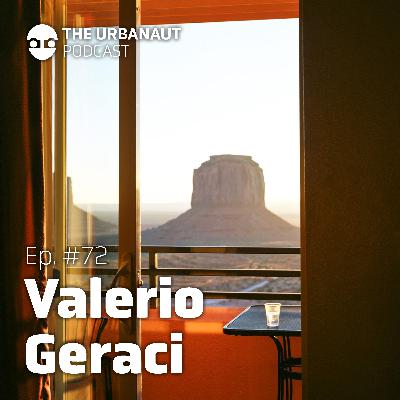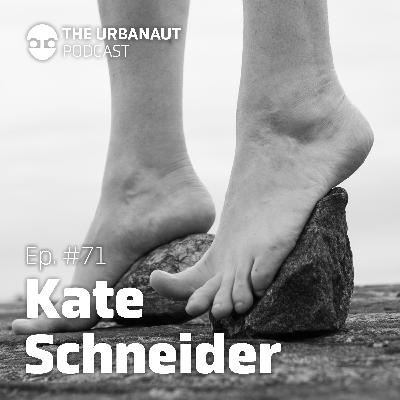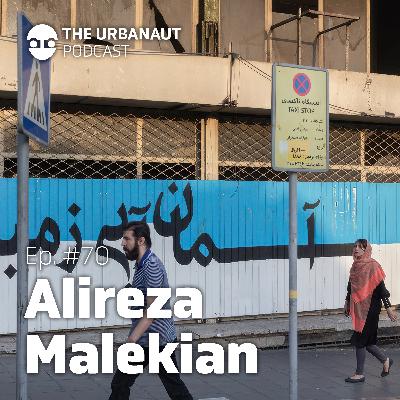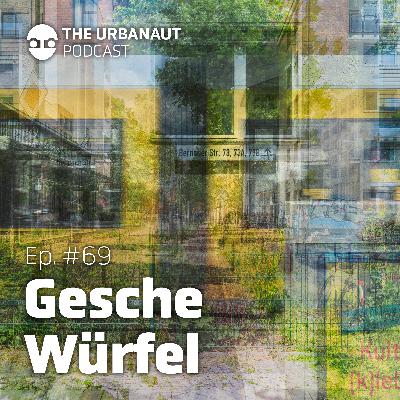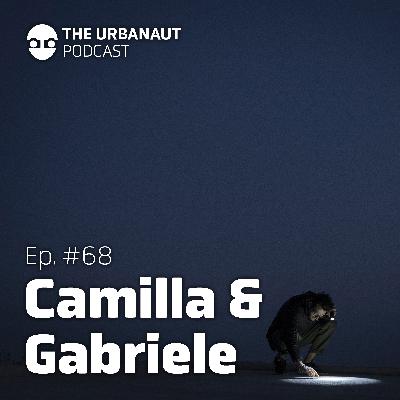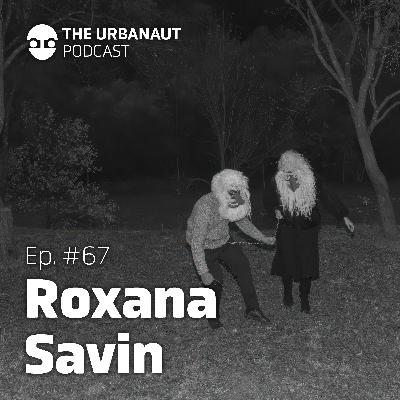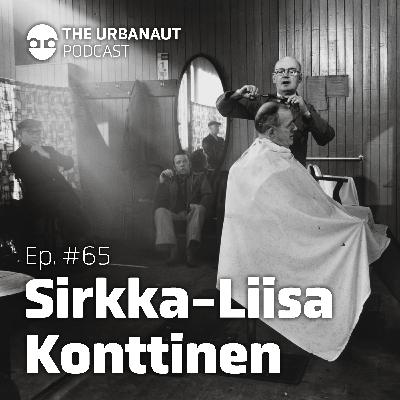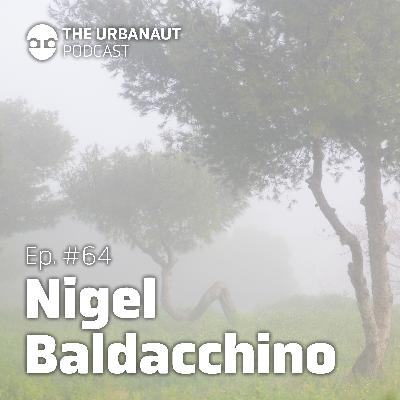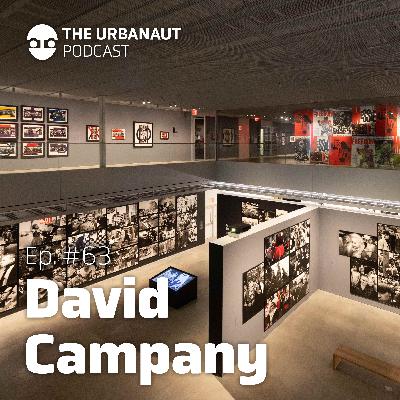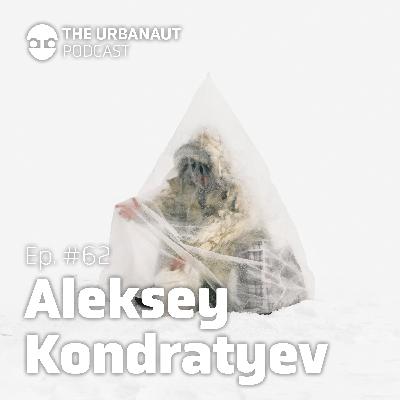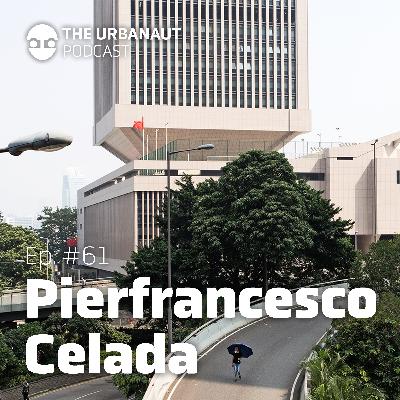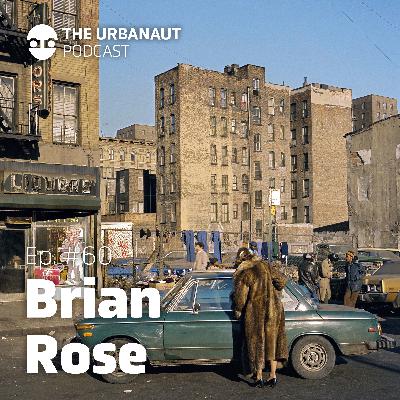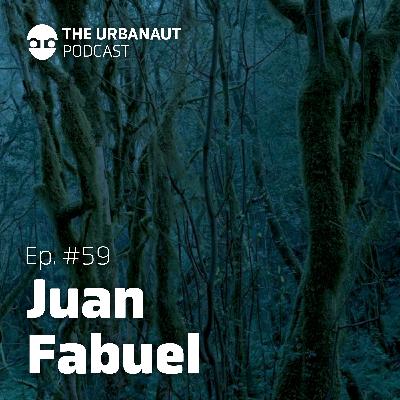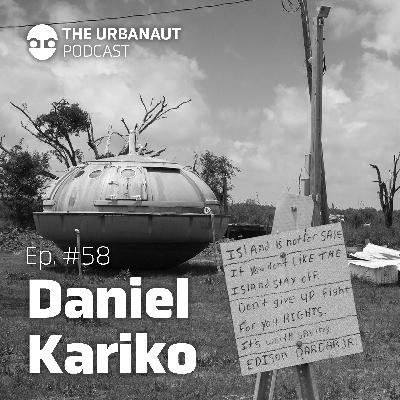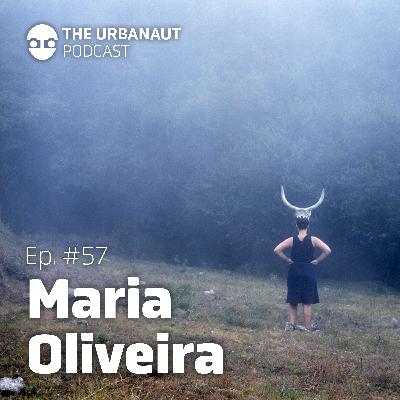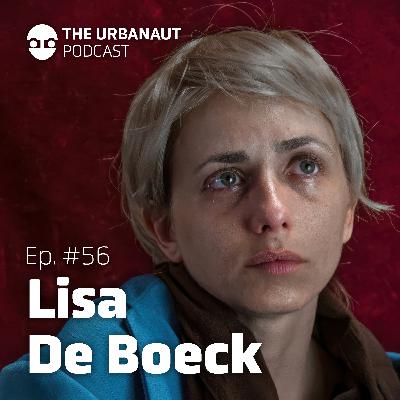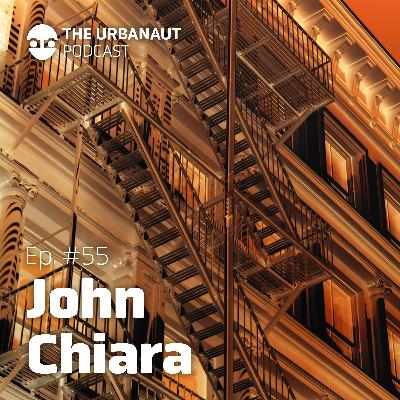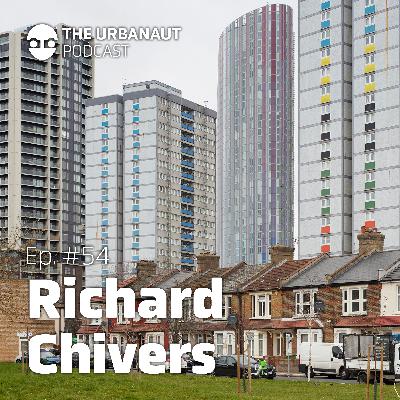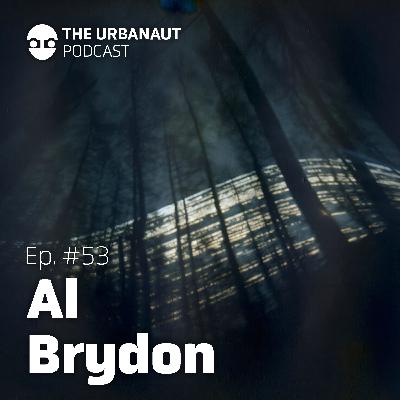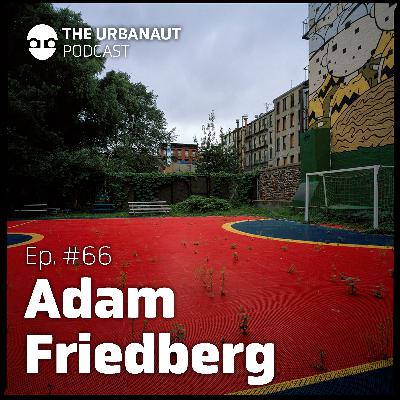Discover The Urbanaut Podcast
The Urbanaut Podcast

The Urbanaut Podcast
Author: Patrick Lee Hubbard
Subscribed: 5Played: 129Subscribe
Share
© Patrick Lee Hubbard
Description
Welcome to The Urbanaut Podcast channel, where we delve deep into our contemporary image-driven culture. For an immersive experience watch the video version on YouTube or Spotify. Guided by Patrick Lee Hubbard and enriched with insights from Steve Bisson of Urbanautica Institute, we explore the tales and truths that modern visuals weave around us. Every frame and pixel holds a story, and we're here to uncover it. If you're as captivated by this journey as we are, support our quest and get exclusive content by joining our Patreon community. Subscribe, dive in, and become an Urbanaut with us.
73 Episodes
Reverse
🎙️ Welcome to Ep. #72 of The Urbanaut Podcast presented in collaboration with @Urbanautica. In this unforgettable conversation, we’re joined by Italian photographer Valerio Geraci, whose work straddles the poetic and the documentary, weaving themes of identity, memory, and place.About Our Guest: Valerio GeraciBorn in Palermo and based in Paris, Valerio Geraci left behind a legal career to pursue a lifelong passion for photography. His acclaimed body of work includes “American Eden”, a long-term exploration of American landscapes shaped by childhood nostalgia, and “Little Italy”, an ongoing project tracing forgotten Italian stories across rural America. His photography blends technical mastery with deep narrative insight, and his images have been exhibited internationally and featured in publications such as Vogue France, Monocle, and AD Magazine. He is also a faculty member at the Paris College of Art.Tune in to this episode to:- Hear how a book — “East of Eden” — changed Valerio’s life trajectory.- Explore the making of “American Eden” and the cultural weight of nostalgia.- Discover the hidden histories behind “Little Italy” and the Italian diaspora in America.- Reflect on the tension between freedom and responsibility in creative work.Don’t forget to:- Subscribe to our channel for more in-depth artist interviews.- Like and share to support independent photography and storytelling.- Follow us on socials for updates and behind-the-scenes content.EPISODE LINKS:Valerio's Website: www.valeriogeraci.com | Valerio’s Instagram: @valeriogeraciOUTLINE:0:00 - Coming Up..1:58 - Opening & Meeting at Paris Foto 3:50 - From Palermo to Paris: Valerio’s Background 4:56 - The Shift from Law to Photography 8:23 - Influences: Robert Capa, Cuba, and Timshel 14:32 - Family Support & Decision to Move to Paris 19:06 - Starting Out as a Photographer 22:12 - Craft, Discipline & Finding a Visual Voice 27:17 - Childhood Fascination with America 32:29 - American Eden: Origins and Meaning 40:50 - Photography Style: Interiors, Landscapes & Light 51:56 - “Your Camera is Your Passport” 1:01:19 - Meeting James: A Friendship in Nebraska 1:13:45 - Why Nebraska? Love for the American Midwest 1:20:56 - Little Italy: Discovering Italian Legacies in the U.S. 1:32:13 - Cemeteries, Stories & Cultural Echoes 1:43:36 - Macaroni Line, Alamo, and Future of the Project SOCIAL: Twitter: /UrbanautPodcast Facebook: /TheUrbanautPodcast Instagram: /TheUrbanautPodcast Support on Patreon: /TheUrbanautPodcast#ValerioGeraci #TheUrbanautPodcast #Photography #AmericanEden #LittleItaly #ItalianDiaspora #DocumentaryPhotography #ArtisticAwakening #VisualStorytelling #urbanautica #stevebisson #PatrickLeeHubbard
🎙️ Welcome to Ep. #71 of The Urbanaut Podcast, presented in collaboration with Urbanautica.com. In this compelling episode, we welcome Canadian photographer and educator Kate Schneider, whose emotionally resonant work explores the deep ties between land, memory, and identity. From the protest camps of the American Midwest to intimate still lifes of ancient rocks, Kate’s evolving visual language challenges traditional documentary practice and embraces poetic, sensory experience.About Our Guest: Kate SchneiderKate Schneider is an artist of settler ancestry living in Tkaronto (Toronto), deeply rooted in the ecology and history of the Great Lakes region. With a background in both photojournalism and fine art, her practice traverses multiple disciplines, from long-form documentary to deeply personal and experimental photographic works. Kate's recent series—How to Understand a Rock, We, the Heartland, and Landscapes of Resistance—meditate on protest, place, and the unspoken emotional geographies that shape our relationships with the non-human world. Her work has been widely exhibited across North America and published internationally. She also teaches photography at OCAD University in Toronto.Tune in to this episode to:Discover how neurodivergence shaped Kate’s entry into photography and her pursuit of mindfulness through image-making.Explore the intersection of activism and artistic ethics through her documentation of the Keystone XL pipeline and Standing Rock protests.Learn how a transition from traditional documentary led Kate to create more introspective, poetic works involving geology, animacy, and memory.Understand her personal connection to land, and why questions of “home” and “belonging” are central to her creative inquiry.EPISODE LINKS:Kate’s Website: www.kateschneider.netKate’s Instagram: @kateschneiderOUTLINE:0:00 – Coming Up…2:18 – Welcome and Personal Roots6:48 – Photography as Neurodivergent Expression12:45 – Education and Early Influences18:33 – Art vs. Journalism Identity Struggles26:49 – Land, Identity, and Emotional Geography34:18 – Conceptual Foundations and Motivations43:10 – Pipeline Resistance: We, the Heartland49:49 – Protest Camps and Landscapes of Resistance57:00 – Existential Crisis and Activist Ethics1:09:27 – Visualizing Home and Temporary Structures1:18:45 – Post-2017 Artistic Recalibration1:23:04 – Geology, Objects, and Intimacy1:32:20 – Photography as Visual Poetics1:38:18 – Artistic Legacy and Personal Growth2:02:18 – Closing Reflections and Looking AheadSOCIAL: Twitter: /UrbanautPodcast Facebook: /TheUrbanautPodcast Instagram: /TheUrbanautPodcast Support on Patreon: /TheUrbanautPodcast#KateSchneider #TheUrbanautPodcast #Photography #EnvironmentalArt #Geopoetics #ActivismThroughArt #NeurodivergentCreativity #ContemporaryPhotography #ArtandEcology #VisualPoetics #urbanautica #stevebisson #PatrickLeeHubbard
🎙️ Welcome to Ep. #70 of The Urbanaut Podcast, presented in collaboration with Urbanautica.com. In this compelling episode, we journey into the richly layered world of Iranian artist-photographer Alireza Malekian. From early experiments in visual communication to his long-term project Defamiliarizing Iran, Alireza invites us to question what a photograph can be—and how it shapes, and is shaped by, the landscapes and cultures it captures.About Our Guest: Alireza MalekianBorn in Mashhad, Iran, and based in Tehran, Alireza Malekian is a visual artist, researcher, and writer whose work interrogates the intersection of urban environment, cultural identity, and photographic language. A graduate in Illustration with deep roots in graphic design and poetry, Alireza has become known for his conceptual approach to photography—merging experimental technique with documentary intention. His work explores the psychological and political layers of place, often transforming everyday cityscapes into complex visual inquiries. Through projects like Defamiliarizing Iranand Phantom Tehran, he challenges both Western perceptions and internal cultural clichés.Tune in to this episode to:- Explore how personal history, displacement, and memory influence visual storytelling.- Learn about Defamiliarizing Iran, a powerful long-term series that blends manipulation, ambiguity, and visual sequencing.- Discover how photography can become a tool for both civic engagement and existential reflection.- Understand Alireza’s deep commitment to honesty, representation, and the evolving role of the artist.EPISODE LINKS:Alireza’s Website: www.alirezamalekian.com | Instagram: @alireza.malekianCHAPTERS0:00 – Coming Up...2:15 – Welcome & Recording from Iran3:08 – Alireza’s Background and Artistic Roots5:33 – Graphic Design, Poetry, and Early Experiments7:04 – Why Photography Became His Medium10:10 – Photography as a Way to Explore Urban Life12:25 – Learning Through Books, Not Institutions16:06 – Childhood, Memory, and Attraction to Landscapes18:33 – Developing a Personal Voice and Artistic Questioning22:22 – Challenging Stereotypes and Defamiliarizing Iran25:55 – Artistic Influences: Persian Miniatures to Kiarostami30:23 – Creating Early Series and Methodical Approaches38:00 – Photography as a Tool for Belonging40:41 – The Philosophy and Process Behind Defamiliarizing Iran52:12 – On Visual Ethics and Representing Truthfully1:06:42 – Grief and Transformation in Bleed, Despair, Solas1:16:27 – Long-term Narratives in As I Walked Within1:24:45 – New Work: Phantom Tehran and Cultural Complexity1:44:49 – Becoming Participant vs. Observer1:53:24 – Advice on Artistic Growth and Taking CriticismDon’t forget to:- Subscribe for more deep dives into the world of photography and visual culture.- Like this episode to support our mission of thoughtful art dialogue.- Share with anyone passionate about photography, culture, or documentary work.SOCIAL: Twitter: /UrbanautPodcast Facebook: /TheUrbanautPodcast Instagram: /TheUrbanautPodcast Support on Patreon: /TheUrbanautPodcast#AlirezaMalekian #TheUrbanautPodcast #Photography #IranianArt #VisualCulture #DefamiliarizingIran #UrbanPhotography #ExpandedPhotography #ArtTheory #urbanautica #PatrickLeeHubbard #SteveBisson
🎙️ Welcome to Ep. #69 of The Urbanaut Podcast, presented in collaboration with Urbanautica.com. In this compelling episode, we sit down with German-American artist Gesche Würfel, whose interdisciplinary work spans photography, urban planning, and visual sociology. Her projects explore the architecture of memory, historical trauma, and environmental change through experimental, research-based image-making.About Our Guest: Gesche WürfelGesche Würfel is a New York-based visual artist known for her analog and concept-driven photography that investigates the socio-political dimensions of space—whether in forests affected by climate change, architecture tied to slavery and Nazism, or the lingering divisions of post-Wall Berlin.Her work has been exhibited at Tate Modern, Künstlerhaus Bethanien, David Zwirner, International Center of Photography, and many others. She's a recipient of grants from DAAD, the Puffin Foundation, and the North Carolina Arts Council, and her work has been featured in The New York Times, The Guardian, and WIRED.In this episode, we discuss her major projects:- Discover how Gesche Würfel retraced the full length of the Berlin Wall to explore the invisible psychological borders that still divide Germany.- Learn how she uses fire, salt, and solarization to transform photographs into visceral reflections of climate change.- Uncover the stories hidden in America’s neglected slave dwellings and what their preservation—or erasure—says about historical memory.- Explore how architecture becomes a tool of oppression, remembrance, and resistance in Gesche’s research-driven visual practice.Tune in to this episode to:- Explore how photography can serve as visual historiography and socio-political critique- Learn how analog image-making and material experimentation can reflect environmental collapse- Hear how oral histories, archives, and landscapes intersect in the retelling of German and American histories- Gain insight into the emotional and ethical layers of documenting sites of trauma and transformationEPISODE LINKSGesche’s Website: https://geschewuerfel.com | Instagram: @gewuerfelSupport the Book on Kickstarter: The Absence and Presence of the Berlin WallOUTLINE:0:00 - Coming Up…0:44 – Welcome & Introductions1:30 – Gesche’s Journey: From Urban Planning to Visual Art5:38 – Photography, Place, and the Traces of Human Presence11:25 – Global Sameness and the Architecture of Identity15:53 – Influences, Intuition, and Experimental Process24:32 – Forests in the Anthropocene: Climate, Material, and Metaphor37:23 – Architecture of Oppression: From Nazi Camps to Slave Dwellings51:45 – Berlin Wall Project: Absence, Memory, and Reunification1:18:50 – Portraits and Oral Histories: Telling a Fuller Story1:25:10 – The Book: Vision, Kickstarter, and Teamwork1:36:11 – Advice for Artists: Trusting Intuition and Long-Term Thinking1:39:11 – Closing Thoughts and Where to Find Gesche’s WorkSOCIAL: Twitter: /UrbanautPodcast Facebook: /TheUrbanautPodcast Instagram: /TheUrbanautPodcast Support on Patreon: /TheUrbanautPodcast#GescheWürfel #TheUrbanautPodcast #BerlinWall #ClimateChangeArt #ExperimentalPhotography #SociopoliticalArt #SlaveDwellings #HolocaustMemory #PostWallGermany #Urbanautica #PhotographyPodcast #ContemporaryPhotography #ArtAndActivism #VisualSociology #PatrickLeeHubbard #SteveBisson
Welcome to Ep. #68 of The Urbanaut Podcast, presented in collaboration with Urbanautica.com. In this thought-provoking episode, we sit down with the creative duo Camilla Marrese and Gabriele Chiapparini—two artists whose collaborative work challenges conventions in photography, publishing, and storytelling. Known for their poetic book "Thinking Like an Island", the pair explore how photography can be both an act of discovery and a deeply personal narrative. About Our Guests: Camilla Marrese & Gabriele Chiapparini Camilla is a photographer, graphic designer, and visual editor at PHMuseum, known for her meticulous approach to photo book design and her narrative sensibility. Gabriele began his artistic path through music before turning to photography, bringing with him a deep sensitivity to sequencing and atmosphere. Together, they’ve formed a creative practice that blurs authorship and embraces intuition, experimentation, and deep research.Their acclaimed project "Thinking Like an Island"—shot on the remote Sicilian island of Alicudi—is a lyrical meditation on isolation, perception, and the desire to escape. The book, structured as four interlocking volumes, reflects both the physical disorientation of island life and the conceptual fragmentation of modern existence.Tune in to this episode to:- Hear the story of how Camilla and Gabriele met, merged practices, and developed their first collaborative projects.- Explore how photography and music intersect through rhythm, tone, and emotional pacing.- Discover the conceptual and logistical challenges behind their book "Thinking Like an Island".- Learn how photobooks become tactile, multi-sensory works of art.- Get an exclusive preview of their upcoming projects on climate science and militarized aesthetics. Don’t forget to: - Subscribe to our channel for deep dives into photography and visual storytelling. - Like and share this episode to support independent photographic voices. - Follow us for behind-the-scenes updates, interviews, and upcoming features.EPISODE LINKS:Camilla’s Instagram: @camillamarrese Gabriele’s Instagram: @gabrielechiappariniPHMuseum: phmuseum.comOUTLINE:0:00 - Coming Up...2:36 - Intro 4:14 - Artistic Roots and Emotional Entry Points 8:09 - First Projects and Formative Experiments 9:44 - Becoming a Duo: Morocco and Merging Visions 12:34 - Melancholy and Mutual Fascination 15:18 - Sequencing Photos Like Music 20:21 - Albums vs. Singles: Why Photobooks Matter 22:46 - Inspirations from Literature and Photography 28:51 - What Makes a Great Photobook? 35:34 - Thinking Like an Island: Utopia, Escape, and Modern Myth 41:25 - Discovering Alicudi and Island as Concept 47:21 - Designing a Disorienting Book Structure 54:13 - Shooting in All Directions: Techniques and Tools 1:01:17 - Themes of Hiding, Camouflage, and Elusive Truths1:03:09 - Layering Voices: Diaries and Islander Quotes 1:07:37 - Living on the Island: Terrain, Limitations, Time 1:14:01 - What the Island Taught Us About Reality 1:16:57 - Ethics of Representation and Local Reception 1:19:49 - Imagining an Exhibition of “The Island” 1:21:18 - Sneak Peek: Climate and Military-Inspired Projects 1:27:23 - Science as Ritual and Intimate Uncertainty 1:29:51 - Collaborating as a Duo: Contrast and TrustSOCIAL: Twitter: /UrbanautPodcast Facebook: /TheUrbanautPodcast Instagram: /TheUrbanautPodcast Support on Patreon: /TheUrbanautPodcastTAGS: #TheUrbanautPodcast #CamillaMarrese #GabrieleChiapparini #TheIsland #PhotobookDesign #PhotographyPodcast #ContemporaryPhotography #Alicudi #VisualNarrative #ClimateArt #CollaborativeArt #PhotobookLove #Urbanautica #SteveBisson #PatrickLeeHubbard
🎙️ Welcome to Ep. #67 of The Urbanaut Podcast, presented in collaboration with Urbanautica.com. In this compelling episode, we sit down with the insightful Swiss-based visual artist Roxana Savin, originally from Romania. Roxana's diverse body of work explores deep themes of identity, belonging, gender roles, and the status of women in contemporary society, influenced by her personal experiences and rich cultural heritage.About Our Guest: Roxana Savin Roxana Savin navigates complex narratives through her photography, transitioning from a legal career in Romania to a profound engagement with visual art. Her projects, such as 'On Heaven's Doorsill' and 'I’ll Be Late Tonight', offer a thoughtful exploration of societal roles and personal identity, reflecting her experiences both in Eastern Europe and as an expatriate in Western societies. Her work has been internationally acclaimed, earning her numerous awards and exhibitions across Europe.Tune in to this episode to:Explore Roxana's transformative journey from a law professional to a celebrated visual artist.Delve into her poignant projects that discuss gender roles, migration, and cultural identity.Discover how her Romanian heritage and personal narratives influence her artistic expression.Don't forget to:Subscribe to our channel for more episodes that delve into the world of art and visual culture.Like and share this episode to support discussions on gender roles and personal transformation in art.Follow us on social media for updates and exclusive behind-the-scenes content.EPISODE LINKS: RRoxana's Webiste: www.roxanasavin.com | Roxana’s Instagram: @roxanasavinOUTLINE:0:00 - Coming Up...2:51 - Introduction3:42 - Roxana’s Early Life and Career Shift9:19 - Migration and the Impact of Moving Abroad11:51 - Finding Art and Embracing Change17:54 - Gender Equality and Advocacy25:18 - 'On Heaven's Doorsill' Project35:04 - 'I’ll Be Late Tonight' Project40:34 - 'God Created Woman' Project48:01 - Artistic Processes and Creative Insights56:33 - Reflections on Cultural Identity and Artistic Expression1:05:04 - Balancing Motherhood and Artistic Career1:13:26 - Societal Impact and Future Directions1:21:50 - Concluding Thoughts1:29:38 - Exploring the Concept of Home and Belonging1:37:13 - Artistic Reflections and Philosophical Insights1:45:46 - Impact of Art on Personal and Social Change1:53:24 - Closing Remarks and Advice for Emerging Artists2:01:39 - Future Projects and FarewellSOCIAL:Twitter: /UrbanautPodcastFacebook: /TheUrbanautPodcastInstagram: /TheUrbanautPodcastSupport on Patreon: /TheUrbanautPodcast#RoxanaSavin #TheUrbanautPodcast #Photography #VisualArt #SwissArt #RomanianArt #CulturalIdentity #GenderRoles #VisualNarrative #ArtisticExploration #urbanautica #stevebisson #PatrickLeeHubbard
🎙️ Welcome to Ep. #65 of The Urbanaut Podcast, presented in collaboration with Urbanautica.com!In this captivating episode, we sit down with the legendary Finnish-British photographer Sirkka-Liisa Konttinen, whose work has profoundly shaped documentary photography in Britain. From her groundbreaking project Byker, capturing a working-class community in Newcastle, to her poetic exploration of life on the North East beaches in Writing in the Sand, Konttinen’s career spans over five decades of deeply human storytelling.About Our Guest: Sirkka-Liisa KonttinenSirkka-Liisa Konttinen is a photographer and filmmaker, co-founder of the Amber Film & Photography Collective, and an MBE awardee for her contributions to photography. Her work is held in prestigious collections, including the Tate, National Gallery of Art (Washington D.C.), and the UK Memory of the World Register.Konttinen’s practice is deeply embedded in the communities she documents, often spanning decades. She first moved to Newcastle in 1969, where she produced Byker, a seminal documentary of a disappearing way of life. She later revisited the area for Byker Revisited, capturing the changes in the community and its people. Her work is not just about capturing moments; it’s about relationships, memory, and the evolution of place.Tune in to this episode to:- Follow Sirkka-Liisa’s journey from Finland to Britain and into the world of photography.- Learn how she co-founded Amber Collective and their philosophy of creative independence.- Explore her Byker and Byker Revisited projects—how she lived among her subjects and documented their lives over decades.- Discover how her photographs turned into films, including Writing in the Sand and Today I’m With You.- Hear incredible behind-the-scenes stories, including the mystery grandma and the barber who rejected his own portrait.Don't forget to:- Subscribe to our channel for more deep dives into the world of photography and art.- Like & share this episode to spread the stories of documentary photography.- Follow us on social media for updates, behind-the-scenes content, and exclusive interviews.OUTLINE:0:00 - Coming Soon…1:50 - Early Life in Finland & First Encounters with Photography5:09 - The Chocolate Bar Hustle: Buying Her First Enlarger7:41 - Studying in London & Discovering Documentary Film11:19 - Why Documentary? Photography as a Time Capsule14:07 - Meeting Murray Martin & Founding the Amber Collective15:06 - Living on £8 a Week: The Amber Collective’s Philosophy28:12 - Newcastle’s Beaches: The Birth of a 20-Year Project31:39 - The Mystery Grandma: A Photograph with Many Claimants35:57 - Photography as Performance: Camouflaging with a Bikini38:07 - The Writing in the Sand: From Photographs to Film39:06 - The Cinematic Nature of Photography49:22 - Returning to Negatives: Finding Hidden Gems57:55 - Byker: A Community on the Brink of Change1:15:45 - The Barber Who Rejected His Own Portrait1:22:47 - The Byker Book: A Local Treasure1:26:59 - Reflections on a Life in Documentary Photography1:33:37 - Losing the Studio: The Break-In That Changed Her Approach1:37:05 - The Abandoned Piano Girl & A Lasting Connection1:40:32 - The Impact of Community Photography: Still Here, Byker1:54:00 - Closing Thoughts & Where to Find Sirkka’s WorkSOCIAL LINKS:Amber Collective & Films: amber-online.comSirkka-Liisa’s Work & Books: Dewi Lewis PublishingWatch Amber’s Films (Including Writing in the Sand): VimeoFollow The Urbanaut Podcast: Twitter: /UrbanautPodcast Facebook: /TheUrbanautPodcast Instagram: /TheUrbanautPodcast Support us on Patreon: /TheUrbanautPodcast#SirkkaLiisaKonttinen #TheUrbanautPodcast #Photography #DocumentaryPhotography #AmberCollective #Byker #WritingInTheSand #VisualNarrative #ArtisticExploration #Urbanautica #SteveBisson #PatrickLeeHubbard
🎙️ Welcome to Episode #64 of The Urbanaut Podcast, presented in collaboration with Urbanautica.com.In this compelling episode, we sit down with Maltese artist and design architect Nigel Baldacchino, whose work spans photography, architecture, poetry, and experimental music. Nigel's unique artistic approach blends deep philosophical inquiry with intuitive photographic practice, resulting in visually and conceptually rich projects. From exploring themes of anxiety and perception to discussing his international exhibitions, this episode offers an insightful look into Nigel’s creative world.About Our Guest: Nigel BaldacchinoNigel Baldacchino (b. 1989, Malta) is an artist and design architect known for his diverse creative output. His photo-text publication Soon Out of Context (2019) combined poetry with found imagery, while his experimental ambient project Pool Night (2021) introduced his sonic explorations under Belgian label Complex Holiday. In 2023, he was part of the prestigious Penumbra Foundation Long-Term Photobook Program, and in 2024, he served as exhibition designer for the first edition of MaltaBiennale.Art. His photography has been exhibited internationally, including at the Musée des Beaux-Arts de Mulhouse, alongside artists such as Raymond Meeks, Awoiska van der Molen, Bénédicte Blondeau, and Bernard Plossu.Tune in to this episode to:- Explore Nigel’s transition from architecture to photography and how it shaped his artistic voice.- Learn how anxiety fuels his creative process and his thoughts on the connection between mental health and art.- Discover the story behind "Those Eyes, These Eyes, They Fade," a traveling exhibition he co-founded.- Unpack his photographic series "The Sea" and its themes of contradiction and perception.- Hear the fascinating history behind "Pineto," his project documenting a forgotten Maltese park before its erasure.- Get a glimpse into his upcoming solo exhibition in South Korea and what’s next in his career.Don’t Forget to:- Subscribe to the podcast for more deep dives into contemporary photography and creative expression.- Like & Share this episode to support independent artists.- Follow us on social media for updates and behind-the-scenes content.EPISODE LINKS:Nigel Baldacchino’s Website: nigelbaldacchino.com | Nigel’s Instagram: @nigelbaldacchinoOUTLINE:0:00 - Coming Up…1:48 - Welcome & Introduction3:40 - From Architecture to Photography5:05 - Founding Those Eyes, These Eyes, They Fade7:25 - Building Community in the Art World28:19 - The Impact of Mentors & Influences31:29 - How Anxiety Fuels Creativity41:50 - Nigel’s Free-Flowing Approach to Photography58:45 - The Poetic Nature of Nigel’s Photography1:05:35 - Exploring Contradictions in The Sea1:27:29 - Using a 500mm Lens to Capture Hidden Stories1:32:46 - The Erasure of History in Malta’s Pineto Park1:37:10 - First Solo Exhibition in Korea1:38:20 - New Work: Promise Litter1:47:56 - The Role of Text in Photography1:51:48 - Closing Thoughts & Future ProjectsSOCIAL MEDIA: Twitter/X: /UrbanautPodcast Facebook: /TheUrbanautPodcast Instagram: /TheUrbanautPodcast Support on Patreon: /TheUrbanautPodcast#NigelBaldacchino #TheUrbanautPodcast #Photography #FineArtPhotography #Architecture #AnxietyAndArt #PhotoBooks #CreativeProcess #Urbanautica #SteveBisson #PatrickLeeHubbard
🎙️ Welcome to Ep. #63 of The Urbanaut Podcast, presented in collaboration with Urbanautica.com.In this thought-provoking episode, we sit down with the brilliant David Campany, an influential curator, writer, editor, educator, and the Creative Director of the International Center of Photography, New York. Known for his deep insights into photography’s evolving role in contemporary culture, David’s work spans curation, academic writing, and photographic criticism.About Our Guest: David CampanyDavid Campany has worked with some of the most prestigious institutions worldwide, including Tate, MoMA, Centre Pompidou, ICP New York, Stedelijk Museum Amsterdam, and The Photographer’s Gallery London. He has published extensively with Aperture, Steidl, MIT Press, Thames & Hudson, and Phaidon, and has written over 300 essays on photography. His recent curatorial projects include A Trillion Sunsets: A Century of Image Overload, Actual Size! Photography at Life Scale, and the William Klein retrospective Yes at ICP.In this episode, we take a deep dive into photography’s role in visual culture, its relationship with power, and the philosophical questions surrounding its meaning.Tune in to this episode to:- Explore why photography resists a singular definition and how its meaning shifts over time.- Unpack the explosion of images in the digital age—are there really "too many photographs"?- Discuss AI’s role in reshaping visual culture—is AI "perfecting ideology"?- Hear about David’s journey into curation and his experience editing iconic photobooks.- Discover why ambiguity is crucial in art and photography, and how institutions often get it wrong.Don't forget to:- Subscribe for more in-depth conversations on photography, art, and visual culture.- Like & Share to spread the word about this insightful discussion.- Follow us for updates, behind-the-scenes content, and upcoming guests.EPISODE LINKS:🔗 David’s Website: www.davidcampany.com📸 David’s Instagram: @davidcampanyOUTLINE:0:00 - Coming Up…2:09 - Introduction & Setting the Stage4:28 - Who is David Campany?6:14 - Photography as an Open Concept8:25 - The Evolution of Photography in Visual Culture11:35 - The Power of Images & Image Manipulation13:38 - Are There Too Many Images in the World?23:12 - AI, Ideology, and the Future of Visual Culture31:44 - David Campany’s Origin Story36:38 - The First Published Photograph & Early Recognition46:53 - Transitioning into Curation1:05:47 - Actual Size: Photography at Life Scale1:18:51 - Ambiguity in Photography & Art1:24:47 - The Role of Writing in Understanding Photography1:29:25 - Photobooks and the Art of Editing1:36:21 - Closing Reflections & Final Thoughts1:40:54 - The Shifting Role of Museums and Institutions1:44:39 - Teaching Photography and Changing Student Perspectives1:49:21 - The Intersection of Photography and Cinema1:52:49 - Why Photographic Meaning is Never Fixed1:56:29 - The Final Take: What Makes Photography Timeless?SOCIAL:🐦 Twitter: /UrbanautPodcast📘 Facebook: /TheUrbanautPodcast📷 Instagram: /TheUrbanautPodcast💡 Support on Patreon: /TheUrbanautPodcast🎧 #DavidCampany #TheUrbanautPodcast #Photography #VisualCulture #CuratingPhotography #AIinPhotography #ArtandAmbiguity #PhotographyTheory #urbanautica #SteveBisson #PatrickLeeHubbard
🎙️ Welcome to Ep. #62 of The Urbanaut Podcast, presented in collaboration with Urbanautica.com.In this captivating episode, we sit down with Aleksey Kondratyev, an artist-photographer whose work explores the intersections of globalization, labor, and identity. From the frozen landscapes of Kazakhstan’s ice fishers to the hidden labor force of American construction workers, Aleksey’s photography brings attention to unseen worlds.About Our Guest: Aleksey KondratyevBorn in Bishkek, Kyrgyzstan, and later immigrating to Detroit, Aleksey’s work is shaped by his personal history of migration and cultural hybridity. He holds an MFA from UCLA and has exhibited internationally at venues like the Museum of Contemporary Art Rome, the Benaki Museum in Athens, and the Berlin Center for Contemporary Art. His projects, including Ice Fishers, Auto, and Worker, have been featured in National Geographic, The New York Times, and The Financial Times.Tune in to this episode to:- Explore Aleksey’s journey in photography and how he found his artistic voice.- Learn about the Ice Fishers project, which documents Kazakh fishers using discarded plastic materials as makeshift survival shelters.- Understand the economic and social dynamics behind the global trade of used cars in the Auto project.- Discuss the invisible workforce behind modern cities in his Worker series.- Hear insights on balancing research and intuition in creative work.Don't forget to:- Subscribe to our channel for more episodes diving into the world of art and photography.- Like & Share this episode to support independent photography storytelling.- Follow us on social media for updates and exclusive behind-the-scenes content.EPISODE LINKSWebsite: alekseykondratyev.com | Instagram: @aleksey.kondratyevOUTLINE:0:00 - Coming Up..2:21 - Introduction to Aleksey Kondratyev25:37 - Discovering the Ice Fishers project28:30 - The extreme conditions of ice fishing1:13:28 - Transition to Auto: A personal connection1:15:26 - The global trade of wrecked cars1:31:19 - The Worker series: Capturing invisible labor1:33:40 - The role of anonymity in photography1:24:11 - The future of auto shops & changing labor markets1:54:55 - Trusting intuition over research1:53:41 - Final thoughts & advice for young photographersSOCIAL LINKS:🔹 Twitter: /UrbanautPodcast🔹 Facebook: /TheUrbanautPodcast🔹 Instagram: /TheUrbanautPodcast🔹 Support us on Patreon: /TheUrbanautPodcast #AlekseyKondratyev #TheUrbanautPodcast #Photography #DocumentaryPhotography #CentralAsia #PostSovietIdentity #LaborPhotography #ArtisticExploration #Urbanautica #SteveBisson #PatrickLeeHubbard
🎙️ Welcome to Ep. #61 of The Urbanaut Podcast, presented in collaboration with Urbanautica.com. In this compelling episode, we delve into the nuanced world of Italian photographer Pierfrancesco Celada. His extensive work offers a chronological exploration of his photography, from his doctoral research in biomechanics to his impactful long-term projects documenting urban life in cities like Hong Kong and Tokyo.About Our Guest: Pierfrancesco Celada Pierfrancesco Celada's work poignantly captures the essence of metropolitan living and its impact on individual and collective consciousness. Known for his incisive use of visual metaphors, Celada's projects like "When I feel down I take the train," and "Instagram Pier," explore themes of isolation, connectivity, and the personal vs. public spheres in urban environments. His photographs have been showcased in major venues such as Les Rencontres d’Arles and the Nobel Peace Center, reflecting his critical acclaim in the field. Dive deeper into his work at www.pierfrancescocelada.com and follow his visual journey on Instagram: @fotografante.Tune in to this episode to:Traverse Pierfrancesco's photographic career, from its inception in the scientific field to the extensive urban studies in his latest projects.Unpack the narratives and artistic processes behind his major works.Understand the influence of rapid urbanization and digital social spaces on contemporary life.Don't forget to:Subscribe to our channel for more episodes that delve into the art of photography.Like and share this episode to appreciate the complex interplay of urban environments and photographic expression.Follow us on social media for updates and exclusive behind-the-scenes content.EPISODE LINKS: Pierfrancesco's Contact: www.pierfrancescocelada.com Pierfrancesco’s Instagram: @fotografanteMuddy Island Books: https://muddyisland.bigcartel.com/OUTLINE: 0:00 - Coming Up…1:27 - Introduction and Background19:32 - Creation of a Publishing House24:03 - Documenting Urban Isolation in Japan35:54 - Experiences Documenting Hong Kong Protests42:29 - Instagram Pier Project57:43 - Real Estate and Urban Dynamics1:06:38 - Cultural Phenomenon of Hikikomori1:17:15 - Ethical Considerations in Documentary Photography1:23:38 - Photographic Composition and Technique1:27:44 - Dynamic Use of Instagram Pier1:35:48 - Adapting to COVID-19 Restrictions1:43:57 - 'Walking Circles' Project1:51:53 - Advice to Aspiring Photographers1:54:40 - Conclusion and Engagement EncouragementSOCIAL:Twitter: /UrbanautPodcastFacebook: /TheUrbanautPodcastInstagram: /TheUrbanautPodcastSupport on Patreon: /TheUrbanautPodcast#PierfrancescoCelada #TheUrbanautPodcast #UrbanPhotography #DocumentaryPhotography #VisualNarrative #ArtisticExploration #Urbanautica #SteveBisson #PatrickLeeHubbard
🎙️ Welcome to Ep. #60 of The Urbanaut Podcast, presented in collaboration with Urbanautica.com.
In this captivating episode, we sit down with renowned photographer Brian Rose, whose work has chronicled some of the most pivotal urban transformations of the past four decades. From the Lower East Side of Manhattan in the 1980sto the fall of the Berlin Wall and beyond, Brian’s photography is a powerful meditation on time, space, and history.
About Our Guest: Brian Rose
Born in Virginia, Brian moved to New York City in 1977 to study at Cooper Union, where he learned from legendary photographers Joel Meyerowitz and Larry Fink. His early work documenting the Lower East Side in the 1980s captured a city on the edge—chaotic, yet full of creative energy. Later, he embarked on a long-term project documenting the Iron Curtain and Berlin Wall, culminating in the critically acclaimed book The Lost Border.
Brian’s photography has since spanned multiple cities and historical moments, from post-9/11 New York to the removal of Confederate statues in Richmond, Virginia. His images are held in prestigious collections, including the Museum of Modern Art (MoMA) and the Metropolitan Museum of Art.
Tune in to this episode to:
- Discover Brian's journey from student to one of urban photography’s most compelling voices.
- Hear behind-the-scenes stories from photographing New York in the 1980s, the fall of the Berlin Wall, and post-9/11 Lower Manhattan.
- Explore his latest project on NYC subway’s last stops and how the city’s outer boroughs tell a deeper story than its landmarks
- Gain insight into self-publishing and how Brian successfully sold 1,000 copies of his book with no advertising campaign.
- Learn why photography is about more than just capturing an image—it’s about documenting history.
EPISODE LINKS:
Brian Rose's Website: www.brianrose.com | Instagram: @brianrosenyc3
OUTLINE:
0:00 - Coming Up...
2:11 – Welcome to the show! Brian’s background and introduction
5:59 – The story of secretly buying his first camera at 16
9:30 – The reversal of photography trends: color vs. black-and-white
13:04 – Inside My Own Color Lab, the photography hub of 1980s NYC
16:20 – Moving to NYC in 1977 and experiencing the NYC blackout
21:53 – Documenting the Lower East Side in 1980—a neighborhood at its rawest
23:40 – Photographing the Iron Curtain and Berlin Wall (1985)
32:17 – Witnessing the fall of the Berlin Wall (1989)
39:09 – The role of photography in social movements
54:22 – Revisiting the Lower East Side after 9/11—capturing gentrification and transformation
1:07:06 – The “Last Stop” project: photographing the NYC subway’s final stations
1:25:27 – The debate: film vs. digital photography and evolving technology
1:34:43 – How Brian sold 1,000 books through self-publishing
1:42:20 – Why he refuses to dwell in nostalgia and continues to photograph the present
1:54:11 – Documenting cultural landscapes—Bangladeshi, Russian, and Orthodox Jewish communities in NYC
1:54:27 – Final reflections and advice for photographers: “Live in the present, photograph in the present.”
Don't forget to:
- Subscribe to our channel for more in-depth conversations on photography, art, and urban culture.
- Like & share this episode to celebrate the rich visual storytelling of urban photography.
- Follow us on social media for behind-the-scenes content and future episodes!
SOCIAL:
Twitter: /UrbanautPodcast
Facebook: /TheUrbanautPodcast
Instagram: /TheUrbanautPodcast
Support on Patreon: /TheUrbanautPodcast
#BrianRose #TheUrbanautPodcast #Photography #DocumentaryPhotography #UrbanPhotography #LowerEastSide #BerlinWall #NYCPhotography #SelfPublishing #PhotographyHistory #Urbanautica
🎙️ Welcome to Ep. #59 of The Urbanaut Podcast, presented in collaboration with Urbanautica.com. In this episode, we sit down with the remarkable Spanish artist Juan Fabuel. Known for his multidisciplinary approach, Juan’s work blends photography, anthropology, and installation art to explore themes of time, memory, movement, and representativeness.
About our Guest:
Juan Fabuel’s artistic practice is deeply rooted in both intimate and societal structures. Utilizing mediums such as photography, video, ceramics, and installation, he creates compelling works that traverse disciplines like anthropology, ecology, and futures studies. Juan’s projects, including 14:24, Blood Remembering, and Becoming Exergy, challenge conventional boundaries of photography, inviting audiences into profound dialogues about identity, place, and the passage of time.
Tune into this Episode To:
Learn about Juan’s artistic evolution, from his early inspirations to his current multidisciplinary practice.
Delve into the personal and universal themes in projects like Blood Remembering and 14:24.
Explore the philosophical and technical processes behind his work with darkness, sound, and memory.
Gain insights into the intersection of art and anthropology.
Don't forget to:
Subscribe to our channel for more episodes diving into the world of art, photography, and anthropology.
Like and share this episode to celebrate Juan’s creative and thought-provoking journey.
Follow us on social media for updates and exclusive behind-the-scenes content.
Episode Links:
Juan’s Instagram: @juan_fabuelJuan’s Website: www.juanfabuel.com
Outline:
0:00 - Coming Up...0:48 - Welcome to Juan Fabuel2:41 - Juan’s multidisciplinary background and early inspirations4:34 - First memories of photography and learning from his grandfather7:18 - Grant project in Brazil combining photography and anthropology14:00 - Working with renowned artists and mentors23:32 - Life-changing feedback during studies at ICP45:30 - Completing his father’s dream in Blood Remembering56:46 - The creative use of darkness in 14:241:03:59 - Philosophical reflections on time and photography1:09:25 - A focus on breathing and political speech in Hold My Breath1:15:26 - Migration and human movement in 14:241:20:20 - Personal memory and lenticular images in Becoming Exergy1:45:00 - Audience interaction and impermanence in Blood Remembering1:52:56 - Reflections on migration and hope in 14:241:59:00 - Closing thoughts on agency and transformation through art
Social:
Twitter: /UrbanautPodcast
Facebook: /TheUrbanautPodcast
Instagram: /TheUrbanautPodcast
Support on Patreon: /TheUrbanautPodcast
#JuanFabuel #TheUrbanautPodcast #Photography #Anthropology #ArtisticExploration #DarknessInArt #VisualStorytelling #Migration #Memory #MultidisciplinaryArt #Urbanautica #SteveBisson #PatrickLeeHubbard
🎙️ Welcome to Ep. #58 of The Urbanaut Podcast, presented in collaboration with Urbanautica.com. In this insightful episode, we explore the intersections of art, science, and cultural identity with Daniel Kariko, a distinguished Professor of Fine Art Photography at East Carolina University.
About Our Guest:
Daniel Kariko Daniel Kariko's photography critically examines environmental, political, and cultural landscapes. His projects span from the war-torn Balkans to the rapidly eroding wetlands of Louisiana, capturing the profound changes within these environments. Kariko combines traditional photography with advanced imaging techniques, offering a unique perspective on the natural and built environments.
Tune in to this episode to:
- Discover the depth of Daniel's projects that document both the environmental degradation in Louisiana and the socio-political aftermath in Serbia.
- Delve into his innovative use of scanning electron microscopy to portray suburban insect life, bridging the gap between art and scientific inquiry.
- Hear Daniel's thoughts on the future of photography and its role in documenting and responding to global changes.
Don't forget to:
- Subscribe to our channel for more episodes that delve into the worlds of art, science, and cultural studies.
- Like and share this episode to spread awareness about the environmental and cultural issues discussed.
- Follow us on social media for updates and exclusive content.
OUTLINE:
0:00 - Coming Up...
2:39 - Introduction and Early Inspirations: From Serbia to the U.S.
6:43 - First Darkroom Experience: A spark in the dark
14:42 - College Choices and Shift in Major: From engineering to art
24:53 -Artistic Influences: Shaping a minimalistic aesthetic
34:42 - Artificial Intelligence and Photography: Future impacts
40:28 - Ongoing Projects in Serbia: Merging personal history with social observation
49:02 - Social Commentary Through Art: Reflecting societal issues
57:26 - Cultural Identity and History: The Balkans' turbulent past
1:15:00 - Suburban Symbiosis Project: Art meets entomology
1:24:49 - Book Publication and Scientific Collaboration: Bridging disciplines
1:35:34 - Environmental Changes in Louisiana: Documenting ecological shifts
1:45:00 - Future of Photography and Art: Anticipating changes
1:55:27 - Reflections on Personal and Artistic Growth: A lifetime of insights
2:05:49 - Closing Thoughts and Look Ahead: The evolving nature of art and photography
SOCIAL:
Twitter: /TheUrbanautPodcast
Facebook: /TheUrbanautPodcast
Instagram: /TheUrbanautPodcast
Support on Patreon: /TheUrbanautPodcast
#DanielKariko #TheUrbanautPodcast #Photography #EnvironmentalArt #DocumentaryPhotography #ArtScience #Urbanautica
🎙️ Welcome to Ep. #57 of The Urbanaut Podcast, presented in collaboration with Urbanautica.com. In this inspiring episode, we sit down with the deeply reflective Portuguese artist-photographer Maria Oliveira. Her work bridges memory, place, and the human connection to nature, offering an intimate exploration of her artistic philosophy and process.
About Our Guest: Maria Oliveira
Maria Oliveira's work is rooted in her upbringing in a small, isolated village in northern Portugal, where silence and nature shaped her artistic voice. Her projects explore themes of memory, motherhood, connection to place, and the fragility of life. Maria's poetic perspective merges the visible and the intangible, creating works that are as introspective as they are universal. Through photography and writing, she examines transitions and the cycles of existence, reflecting a unique sensitivity to the interconnectedness of humanity and nature.
Tune in to this episode to:
Discover Maria’s journey from poetry to photography and how writing remains integral to her creative process.
Explore her projects, from revisiting her childhood home to working with her mother and capturing the fragility of salt fields.
Gain insights into Maria’s artistic philosophy, which emphasizes freedom, intuition, and connection to place.
Delve into the themes of spirituality, feminine archetypes, and the role of silence in creativity.
Don’t forget to:
Subscribe to our channel for more episodes that explore the intersections of art, photography, and human connection.
Like and share this episode to celebrate Maria’s poetic and reflective artistry.
Follow us on social media for updates and behind-the-scenes content.
Episode Links:
Website: www.mariaoliveira.pt | Instagram: @___maria.oliveira___
OUTLINE:
0:00 - Coming Up...2:30 - Introduction and Maria’s Background3:11 - Growing up in an isolated village and its influence6:54 - Starting with poetry as her first artistic expression8:44 - Transitioning to photography and discovering her medium9:44 - Writing as part of her creative process10:44 - Family influence and the absence of an artistic background13:17 - How silence and emptiness shaped her introspection and creativity27:39 - Poetry’s influence and connection to nature37:54 - Revisiting her childhood home and its impact on her work46:37 - Working with her mother and strengthening their bond1:04:54 - Freedom and intuition in her creative practice1:12:07 - The fragility of nature through the metaphor of salt fields1:32:20 - Spirituality, mysticism, and blending the practical with the poetic1:54:12 - Closing reflections on art, place, and Maria’s evolving projects
SOCIAL:
Twitter: /UrbanautPodcast
Facebook: /TheUrbanautPodcast
Instagram: /TheUrbanautPodcast
Support on Patreon: /TheUrbanautPodcast
#MariaOliveira #TheUrbanautPodcast #Photography #PortugueseArt #VisualPoetry #ArtisticExploration #urbanautica #stevebisson #PatrickLeeHubbard
🎙️ Welcome to Ep. #56 of The Urbanaut Podcast, presented in collaboration with Urbanautica.com. This episode features the extraordinary mother-daughter artist duo, memymom—Lisa De Boeck and Marilène Coolens. Together, they’ve spent decades creating an evocative, intergenerational body of photographic work exploring themes of identity, memory, and transformation.
About Our Guests: memymom
Memymom is a unique collaborative project between self-taught artists Lisa De Boeck and her mother, Marilène Coolens, based in Brussels, Belgium. Their work began as a playful photographic archive called The Umbilical Vein (1990–2003), capturing staged, dreamlike moments that reflect their deep bond. Over the years, their practice evolved into highly conceptual and visually intricate projects like The Digital Decade (2010–2015), Somewhere Under the Rainbow (2016–2021), and the ongoing The Fourth Hatch (2022–2032).
Highlight: The Fourth Hatch
Their latest chapter, The Fourth Hatch, expands the memymom universe into new temporal and thematic territory. Exploring themes of evolution, legacy, and reinvention, this project continues their tradition of layered narratives and emotional aesthetics, offering a glimpse into their collaborative vision for the future of their work.
Tune in to this episode to:
- Discover how Lisa and Marilène evolved from casual photography to professional artistry under the moniker memymom.
- Explore their acclaimed series, including The Umbilical Vein, The Digital Decade, Somewhere Under the Rainbow, and The Fourth Hatch.
- Delve into their creative processes, including how they balance individual voices within their collaboration.
- Hear Lisa’s reflections on trusting gut intuition, adapting to changing times, and the emotional highs and lows of large-scale exhibitions.
Don’t forget to:
- Subscribe to our channel for more in-depth conversations with inspiring artists.
- Like and share this episode to celebrate the power of collaborative art.
- Follow us on social media for exclusive behind-the-scenes insights and updates.
OUTLINE:
0:00 - Coming Up...
2:04 - Lisa’s Introduction and Creative Partnership with Her Mom
3:01 - The Digital Decade
5:58 - Loss of Geert Stadius
10:26 - Family Creativity and Humor
21:50 - Transition Behind the Camera
29:00 - Hollywood Dreamscape
37:17 - Cultural Critique: Disney Ears and Dystopia
47:46 - The Umbilical Vein Archive
55:28 - Exploring Image Stories
1:05:04 - Significance of Titles in Art
1:15:29 - Creating Artistic Chapters
1:23:12 - Exploring Solo Work
1:27:04 - Adapting to Changing Times
1:47:46 - The Emotional Weight of Exhibitions
2:03:17 - Gut Feelings and Creative Direction
Learn More About memymom:
🌐 Website: @
📸 Instagram: @memymom | @lisa.de.boeck
SOCIAL:
Twitter: /UrbanautPodcast
Facebook: /TheUrbanautPodcast
Instagram: /TheUrbanautPodcast
Support on Patreon: /TheUrbanautPodcast
#LisaDeBoeck #MarilèneCoolens #memymom #TheUrbanautPodcast #Photography #CollaborativeArt #BelgianArt #ArtisticJourney #TheFourthHatch #MemoryAndIdentity #VisualNarratives #Urbanautica #SteveBisson #PatrickLeeHubbard
🎙️ Welcome to Ep. #55 of The Urbanaut Podcast, presented in collaboration with Urbanutica.com.
In this thought-provoking episode, we sit down with John Chiara, a visionary photographer who has revolutionized analog photography by crafting his own cameras, developing unique processes, and pushing the boundaries of artistic expression.
About Our Guest: John Chiara
After dedicating an extended period in 1995 to making contact prints from his 2-1/4" x 2-1/4" negatives, John Chiara discovered that too much information was lost in the darkroom enlargement process. Over the next six years, he developed his own equipment and processes to create first-generation unique photographs without using film.
Chiara’s work is a hybrid of photography, sculpture, and performance. His process demands inventive tools and immense patience. Using a hand-built 50" x 80" field camera transported on a flatbed trailer, Chiara creates one-of-a-kind photographs. He physically enters the camera, maneuvers large sheets of positive color photographic paper, and uses his hands to burn and dodge during exposures. The resulting images bear traces of this tactile process, combining soft hues with a strong sense of materiality and ephemeral presence.
Chiara’s work has been exhibited at prestigious venues worldwide, including the J. Paul Getty Museum, the George Eastman Museum, and the de Young Museum. He has been commissioned by the Pilara Foundation and participated in exhibitions at the National Gallery of Art in Washington D.C. and the Museum Barengasse in Zurich, among others.
Tune in to this episode to:
- Discover John’s creative journey, from his early inspirations to his boundary-pushing techniques.
- Explore the philosophy behind his unique photographic process.
- Hear captivating stories of resilience, innovation, and artistic exploration, from New York to the Swiss Alps.
OUTLINE:
0:00 - Coming Up…
4:41 - Empowering Perspective
7:00 - Early Inspirations
13:43 - Teenage Crime Scene Assignment
20:06 - Crafting Custom Cameras
25:08 - Influential Artists
30:23 - Memory vs. Nostalgia
45:09 - Controlled Chaos
56:51 - Reinventing New York
1:16:31 - Manhattan Living
1:24:43 - European Travel Mishap
1:26:36 - Swiss Alps During Lockdown
1:29:11 - Art as Process
1:56:17 - Advice for Artist and Photogrpahers
EPISODE LINKS:
John’s Website: www.johnchiara.com
John’s Instagram: @john.chiara_
SOCIAL:
Twitter: /UrbanautPodcast
Facebook: /TheUrbanautPodcast
Instagram: /TheUrbanautPodcast
Support on Patreon: /TheUrbanautPodcast
Don’t forget to:
- Subscribe to our channel for more conversations with groundbreaking artists.
- Like and share this episode to celebrate creative innovation in analog photography.
- Follow us on social media for updates and exclusive content.
#JohnChiara #TheUrbanautPodcast #Photography #AnalogPhotography #ExperimentalArt #ArtisticInnovation #urbanautica #stevebisson #PatrickLeeHubbard
The Urbanaut Pidcast - Richard Chivers🎙️ Welcome to Ep. #54 of The Urbanaut Podcast, presented in collaboration with Urbanautica.com. In this fascinating episode, we sit down with British photographer Richard Chivers, whose work documents the transformation of the British landscape. Richard shares insights into his creative process, personal and professional projects, and the environmental and cultural narratives that inspire him.About Our Guest: Richard Chivers
About our guest:
Richard Chivers is a documentary photographer whose work explores the shaping and reshaping of the British landscape. His practice focuses on how humans modify both urban and natural environments through infrastructure, industry, housing, and leisure—and how these changes affect and define our world.
Richard has received multiple Arts Council awards to create, curate, and exhibit his work, which has been showcased across the UK and internationally. As the co-founder of the Human Endeavour photography collective, Richard developed projects such as Degeneration and The Glasgow Effect, which were exhibited at the Brighton Photo Fringe and the Format International Photography Festival. Now a member of the MAP6 Collective, Richard has worked on recent projects in Milton Keynes, The Shetland Islands, Finland, and Wales.
Episode Links:
Website: www.rchiversphoto.co.ukInstagram: @chiversphotoprojects
Tune in to this episode to:
Learn how Richard’s upbringing and influences shaped his photographic voice.
Explore the cultural and environmental narratives behind his projects, from industrial quarries to disappearing gas holders.
Delve into his documentation of the decline of social housing in Degeneration.
Understand the balance between professional architectural photography and personal exploration.
Discover his process-driven approach to photographing the British landscape.
OUTLINE:
0:00 - Most Replayed0:55 - Richard’s Background and Introduction2:41 - Early Influences: Family and Film5:10 - Switching Careers to Pursue Photography12:03 - University Projects: Insecurity and Early Style11:23 - Exploring Urban and Industrial Landscapes37:24 - The Fascination with Quarries and Geology45:04 - Photographing Greenham Common and Nuclear History1:05:15 - The Collective Project: Degeneration1:14:21 - Documenting the Decline of Gas Holders1:19:00 - Architectural Photography as a Career1:25:00 - Balancing Personal and Professional Projects1:30:29 - Reflection on Process and the Enjoyment of Photography1:34:00 - Challenges of Photographing Familiar Spaces1:42:10 - Nature Reclaiming Industrial Sites1:50:00 - Documenting Social and Environmental Change
SOCIAL:
Twitter: /UrbanautPodcast
Facebook: /TheUrbanautPodcast
Instagram: /TheUrbanautPodcast
Support on Patreon: /TheUrbanautPodcast
#RichardChivers #TheUrbanautPodcast #Photography #DocumentaryPhotography #UrbanLandscapes #ArchitecturalPhotography #MAP6Collective #VisualNarrative #ArtisticProcess #Urbanautica #PatrickLeeHubbard
🎙️ Welcome to Ep. #53 of The Urbanaut Podcast, presented in collaboration with Urbanautica.com.
In this inspiring episode, we sit down with British photographer Al Brydon, whose evocative work explores the intersections of time, place, and memory. Known for his solargraph series and co-founding the 'Inside the Outside' collective, Al offers a glimpse into his creative process and philosophical musings on photography.
About Our Guest: Al Brydon
Al Brydon is a Sheffield-based photographer whose work delves into experimental and narrative-driven photography. A co-founder of the 'Inside the Outside' collective, Al is celebrated for projects like his solargraph series, which uses pinhole cameras to capture long-exposure images over months. His practice reflects a fascination with deep time, imperfection, and the unseen, creating a layered exploration of landscapes and human connection. Al’s work has been exhibited globally and featured in publications such as Solargraphs and Even the Birds Were Afraid to Fly.
Tune in to this episode to:
Discover how Al’s life in Sheffield and the Peak District shapes his creative outlook.
Learn about the six-year journey behind his solargraph series and its philosophical underpinnings.
Reflect on the role of chaos and destruction in art as a means of creation.
Explore the process of turning experimental projects into photobooks.
Gain insights into Al’s approach to storytelling and capturing the ephemeral.
Don’t forget to:
Like this episode to support meaningful conversations about art and photography.
Subscribe to our channel for more in-depth interviews with photographers and creatives.
Share this episode with your community to inspire discussion about experimental photography.
EPISODE LINKS:
Solargraph Prints: Argentea Gallery
Based on a False Story Prints: MMX Gallery
Al's New Book: Even the Birds Were Afraid to Fly: Link
Follow Al on Instagram: @al_brydon
Website: www.al-brydon.com
OUTLINE:0:00 - Coming Up…3:28 - Life in Sheffield: Finding inspiration in an industrial and natural landscape14:32 - Darkroom Revelations: Discovering the magic of photography21:41 - Embracing Chaos: A creative philosophy of destruction and imperfection28:32 - Mirror or Window? Reflecting on photography’s dual purpose40:37 - Solargraphy Explained: Capturing deep time and unseen changes49:18 - Time and Perspective: Exploring non-human perceptions of time56:52 - A Forest’s Death: Documenting the destruction of a pine plantation1:00:18 - Pandemic Anchor: Solargraphs as a source of solace during lockdown1:13:16 - Influences and Inspirations: The artists who shaped Al’s work1:16:56 - Photobook Creation: Turning Solargraphs into a published work1:32:18 - Stories in the Landscape: Unexpected narratives in photography1:47:00 - The Philosophy of Forgetting: Memory, absence, and ephemeral art1:51:14 - Reflections on Art: Intention, interpretation, and artistic legacy
SOCIAL:
Twitter: /UrbanautPodcast
Facebook: /TheUrbanautPodcast
Instagram: /TheUrbanautPodcast
Support on Patreon: /TheUrbanautPodcast
#AlBrydon #TheUrbanautPodcast #Photography #Solargraphs #ExperimentalPhotography #VisualNarrative #ArtisticExploration #urbanautica #PatrickLeeHubbard
🎙️ Welcome to Episode #66 of The Urbanaut Podcast!Presented in collaboration with Urbanautica.com, this episode features the brilliant Adam Friedberg, a New York-based photographer known for his deeply observational work capturing urban spaces, architectural elements, and the changing cityscape.About Our Guest: Adam FriedbergAdam Friedberg’s photography explores the intersection of architecture, space, and absence, often focusing on overlooked environments like empty lots, single-story buildings, and hidden urban details. His career spans from assisting top commercial photographers in the 90s to becoming a highly regarded artist with a distinct voice in architectural and documentary photography. Friedberg’s work balances technical precision with a meditative approach to image-making, inviting viewers to reconsider their surroundings.Tune in to this episode to:- Discover how a Tibetan monk's advice set Adam on his creative journey.- Hear the wild story of how he crashed a fashion photography studio and landed his first job.- Explore the philosophy behind his work—why he focuses on "a thing or not a thing".- Learn about his major projects, including Empty Lots, Single Story, and Urban Jungle.- Gain insights into photography as a trade vs. art form, the evolution of New York, and the tension between commercial and personal work.OUTLINE:0:00 - Coming Up…1:01 - Introduction & Guest Background2:59 - Academia, Philosophy, and the CIA Connection6:30 - The Tibetan Monk’s Advice That Changed Everything7:20 - Accidental Entry into Photography9:27 - Learning Photography Through Immersion12:22 - The Reality of Assisting in High-End Fashion Photography16:00 - The Grueling Pace of Commercial Photography in the 90s29:03 - The Shift from Fashion to Personal Work32:06 - Finding a New Direction in Architectural Photography49:14 - The Concept of “A Thing or Not a Thing” in Photography51:19 - Major Photography Projects & The Evolution of His Work57:14 - The Influence of Books and Prints on Photography1:11:52 - The Role of Imperfection & Photography as a Trade vs. Art Form1:15:02 - The Challenge of Documenting a Changing City1:19:24 - Why He Refuses to Crop His Photos1:41:13 - Final Thoughts & The Nature of SeeingDon't forget to:- Subscribe to our channel for more conversations with artists and photographers.- Like & Share this episode if you enjoy deep-dive discussions on photography and creative practice.- Follow us on social media for updates and behind-the-scenes content.EPISODE LINKS:Adam Friedberg’s Work: www.adamfriedberg.com | Instagram: @adam_friedbergSOCIALS: Twitter: @UrbanautPodcast Facebook: /TheUrbanautPodcast Instagram: @TheUrbanautPodcast Support us on Patreon: /TheUrbanautPodcastHashtags:#AdamFriedberg #TheUrbanautPodcast #Photography #UrbanPhotography #Architecture #NewYork #ArtisticExploration #Urbanautica #PhotographyPodcast #VisualNarrative #Cityscapes






